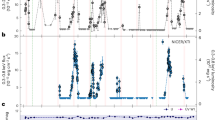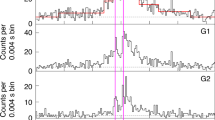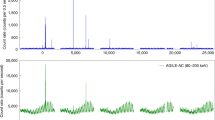Abstract
DIFFERENT kinds of X-ray bursts, as observed from the rapid burster (MXB1730–335) (refs 1, 2) and from other sources3–5, can be classified into two types which, as we will show, may have different origins and production mechanisms. Type I bursts occur at intervals of hours, days or longer. Their spectra almost always soften during burst decay, and their average spectrum during the first few seconds of a burst is generally harder than the spectrum of the associated persistent X-ray emission (if present). Type II bursts occur at intervals of several seconds to minutes, and their spectra do not soften during burst decay. The rapid burster1–6 can produce up to several thousand type II bursts per day. Type II bursts may perhaps also be produced by other X-ray sources such as Cyg X-1 (ref. 7). Type I bursts are produced by all other burst sources reported so far3–5. Here we will show that the rapid burster also produces type I bursts.
This is a preview of subscription content, access via your institution
Access options
Subscribe to this journal
Receive 51 print issues and online access
$199.00 per year
only $3.90 per issue
Buy this article
- Purchase on SpringerLink
- Instant access to full article PDF
Prices may be subject to local taxes which are calculated during checkout
Similar content being viewed by others
References
Lewin, W. H. G. et al. Astrophys. J. Lett. 207, L95 (1976).
Ulmer, M. P., Lewin, W. H. G., Hoffman, J. A., Doty, J. & Marshall, H. Astrophys. J. Lett. 214, L11 (1977).
Lewin, W. H. G. Mon. Not. R. astr. Soc. 179, 43 (1977).
Lewin, W. H. G. Ann. N.Y. Acad. Sci. (in the press).
Lewin, W. H. G. & Joss, P. C. Nature 270, 211–216 (1977).
White, N. E., Mason, K. O., Carpenter, G. F. & Skinner, G. K. Mon. Not. R. astr. Soc. (in the press).
Canizares, C. & Oda, M. Astrophys. J. Lett. 214, L119 (1977).
Lewin, W. H. G. et al. Mon. Not. R. astr. Soc. 177, 93P (1977).
Hoffman, J. A., Marshall, H. & Lewin, W. H. G. IAU. Circ. No. 3117 (1977).
Hoffman, J. A. et al. Astrophys. J. Lett. 210, L13 (1976).
Li, F. K., Lewin, W. H. G., Clark, G. W., Doty, J., Hoffman, J. A. & Rappaport, S. A. Mon. Not. R. astr. Soc. 179, 21P (1977).
Lewin, W. H. G., Hoffman, J. A., Doty, J., Li, F. K. & McClintock, J. E. IAU Circ. No. 3075 (1977).
Hoffman, J. A., Lewin, W. H. G. & Doty, J. Mon. Not. R. astr. Soc. 179, 57P (1977).
Lewin, W. H. G., Doty, J., Hoffman, J. A. & Li, F. K. IAU Circ. No. 2984 (1976).
Lewin, W. H. G. & Hoffman, J. A. IAU Circ. No. 3079 1977).
Hoffman, J. A. IAU Circ. No. 2953 (1976).
Lewin, W. H. G. IAU Circ. No. 3067 (1977).
McClintock, J. E., Rappaport, S. A., Nugent, J. & Li, Fuk K. Astrophys. J. Lett. 216, L15 (1977).
Epstein, A. et al. Astrophys. J. 216, 103 (1977).
Author information
Authors and Affiliations
Rights and permissions
About this article
Cite this article
HOFFMAN, J., MARSHALL, H. & LEWIN, W. Dual character of the rapid burster and a classification of X-ray bursts. Nature 271, 630–633 (1978). https://doi.org/10.1038/271630a0
Received:
Accepted:
Issue date:
DOI: https://doi.org/10.1038/271630a0
This article is cited by
-
AstroSat observation of rapid type-I thermonuclear burst from low-mass X-ray binary GX 3\(+\)1
Journal of Astrophysics and Astronomy (2022)
-
Accretion Disks and Coronae in the X-Ray Flashlight
Space Science Reviews (2018)



